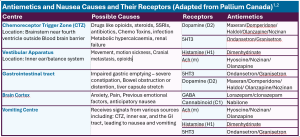Nausea Management Pathways
Nausea and vomiting are commonly experienced symptoms affecting 40-60% of those receiving a palliative approach to care and the cause is often multifactorial1. To treat nausea effectively, we must understand the etiology and likely neurotransmitter and nausea pathways1,2. The most common causes are impaired gastric emptying, chemical causes such as medications and visceral causes from constipation1.
Symptom Assessment 1,2,3
- Use OPQRSTUV Tool
- Assess for signs of dehydration, jaundice, infection, or drug toxicity
- Neurological exam: assess for signs of a cranial lesions or raised ICP
- Abdominal exam: inspection, palpation, percussion and auscultation assess for tenderness, organomegaly, ascites. Absence of bowel sounds or high-pitched tinkling, which is usually from tension of air or fluid in a loop of dilated bowel, suggests obstruction.
- Date of last bowel movement and consistency
- Is vomiting present? Assess frequency, amount and colour
- Review of medications that may be contributing to nausea
- Regular reassessment is essential for symptom control
Antiemetics and Nausea Causes and Their Receptors (Adapted from Pallium Canada)1,2

If Cause is Unknown or by a Multitude of Factors
Unknown causes of nausea occur in10-25% of patients, where on the other hand, nausea caused by multiple factors occurs in 25-62%. Initial antiemetic choices1:
- Metoclopramide: treats gastric stasis, partial bowel obstruction. *Avoid use in complete bowel obstruction * 1,2
- Haloperidol: first choice in treating nausea related to chemical disturbances 1
- Methotrimeprazine (Nozinan): effective when used as a broad acting receptor antagonist1,2,3
Resources:
- B.C. interprofessional palliative symptom management guidelines. Nausea & vomiting. https://www.fraserhealth.ca/-/media/Project/FraserHealth/FraserHealth/Health-Professionals/Professionals-Resources/Hospice-palliative-care/Sections-PDFs-for-FH-Aug31/9524-22-FH—Sym_Guide-Nausea-Vomiting.pdf?sc_lang=en
- Pallium Canada. (2028). Pallium palliative pocketbook: Gastrointestinal problems (Second edition, pp.8-1 to 8-12).
- Cancer Care Ontario. (May 2019). Symptom management algorithm: Nausea and vomiting in adults with cancer. https://www.cancercareontario.ca/en/symptom-management/3131
Download Tip of the Month




